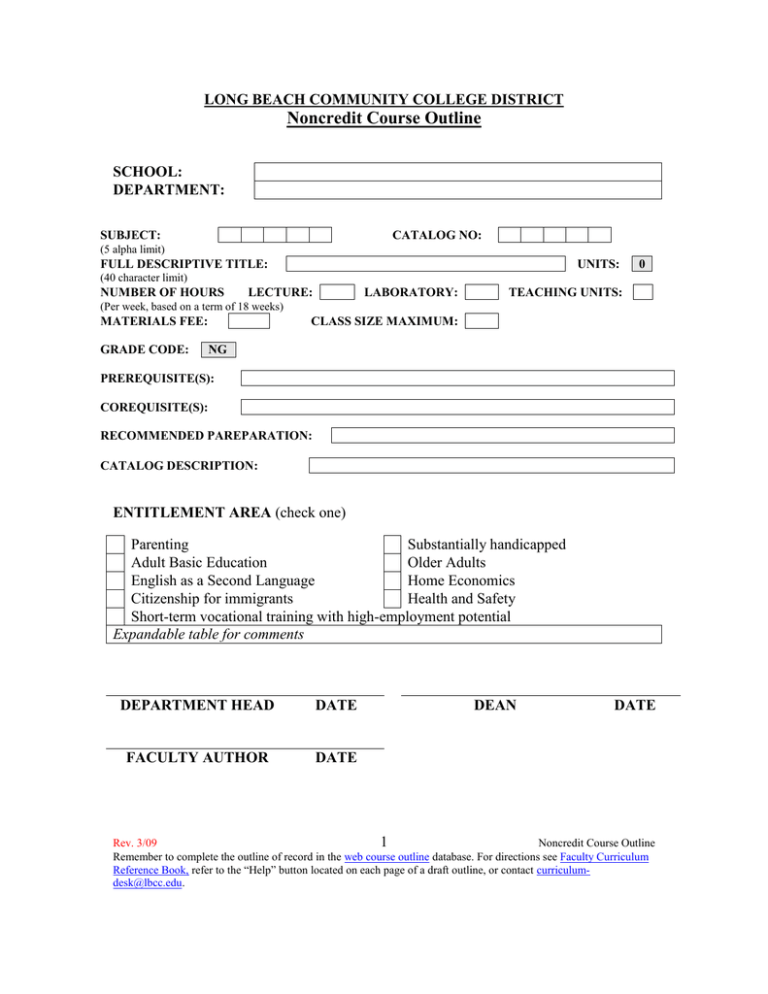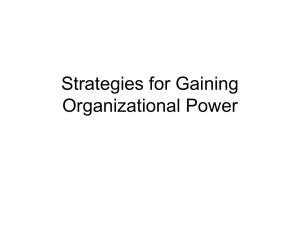Noncredit Course Outline Template
advertisement

LONG BEACH COMMUNITY COLLEGE DISTRICT Noncredit Course Outline SCHOOL: DEPARTMENT: SUBJECT: CATALOG NO: (5 alpha limit) FULL DESCRIPTIVE TITLE: UNITS: 0 (40 character limit) NUMBER OF HOURS LECTURE: LABORATORY: TEACHING UNITS: (Per week, based on a term of 18 weeks) MATERIALS FEE: GRADE CODE: CLASS SIZE MAXIMUM: NG PREREQUISITE(S): COREQUISITE(S): RECOMMENDED PAREPARATION: CATALOG DESCRIPTION: ENTITLEMENT AREA (check one) Parenting Substantially handicapped Adult Basic Education Older Adults English as a Second Language Home Economics Citizenship for immigrants Health and Safety Short-term vocational training with high-employment potential Expandable table for comments DEPARTMENT HEAD DATE FACULTY AUTHOR DATE DEAN DATE Rev. 3/09 1 Noncredit Course Outline Remember to complete the outline of record in the web course outline database. For directions see Faculty Curriculum Reference Book, refer to the “Help” button located on each page of a draft outline, or contact curriculumdesk@lbcc.edu. STUDENT LEARNING OUTCOMES/OBJECTIVES Course level student learning outcomes and objectives are clear and measurable statements that define what a student knows and/or is able to do at the completion of a course. Outcomes and Objectives: Student learning can be identified as either outcomes, which are broad, more global statements or objectives, which are narrow, more specific statements. The difference is primarily that the outcomes demonstrate an overarching understanding and/or application of a core subject aspect while the objectives are the small pieces of subject matter, which build up to the learning outcome(s). Identify the student learning outcomes in the box at the top of this page’s listing. A prompt is already provided so begin each student learning outcome statement with an observable verb from Bloom’s Taxonomy or a comparable taxonomy to complete the sentence. Please number the student learning outcomes. The format of learning objectives on this page consists of four different groups. Identify the learning objectives for the course in the appropriate box(es). Complete the sentence prompt making sure to include an observable verb from Bloom’s Taxonomy or a comparable taxonomy. Please number the learning objectives. All student learning outcomes and objectives must be addressed in the content, methods of presentation, college-level assignments, and methods of evaluation that follow as this is an integrated outline documenting the instructional experience. OUTCOMES Upon completion of the course the student should be able to: OBJECTIVE GROUP ONE: SKILL DEVELOPMENT-APPLICATION Upon completion of the course the student should be able to: Note: an expanding table follows the following statements: the table will expand down with each new line you type. Knowledge skills: The ability to relate general or specialized knowledge relevant to a problem and to implement a solution; also, the ability to locate, retain, and apply relevant knowledge. Critical thinking and reasoning skills: The ability to formulate and analyze problems and to employ rational processes to achieve increased understanding (e.g., the recognition of biased points of view in a speech or a book; the recognition of cause-and-effect relationships). Creative skills: The ability to design, produce, or otherwise bring into existence original perspectives, explanations, and implementations (e.g., the production of unique communication; the development of an effective plan or solution to a problem; or the creation of works of art.). Communication skills: The ability or competence to read, write, speak, and listen. The ability to convey information, attitudes, emotions, etc. and also, the ability to receive and interpret communications. These skills also encompass normal, non-written expression and perception. Motor skills: The ability or competence in tasks requiring physical dexterity and/or skill. OBJECTIVE GROUP TWO: PERSONAL DEVELOPMENT Upon completion of the course the student should be able to: Note: an expanding table follows the following statements: the table will expand down with each new line you type. Physical Health: The physical well being of students. Mental Health: The mental well being of students. Change/Stability: Attitudes toward new and different ideas, relationships, products or methods; the desire to introduce, avoid, or be associated with changes. Self-concept: The feeling and acceptance of oneself as having basic worth and value. OBJECTIVE GROUP THREE: GENERAL KNOWLEDGE Upon completion of the course the student should be able to: Note: an expanding table follows the following statements: the table will expand down with each new line you type. Broad general theory in the discipline. Social attitudes in terms of the relationship of the individual student to the discipline. Cultural knowledge relating the discipline to the culture. Mastering of basic principles, facts, and vocabulary of the discipline. OBJECTIVE GROUP FOUR: SPECIALIZED KNOWLEDGE-DEPTH Upon completion of the course the student should be able to: Note: an expanding table follows the following statements: the table will expand down with each new line you type. Acquisition of essential abstract theory for the discipline. Mastering of facts and basic principles of the discipline. Knowledge of vocabulary and meaning of terms related to the discipline. METHODS OF INSTRUCTION (Identify as many as apply) Under each identified instructional strategy, please explain how the organized instruction is conducted reflecting educational technology and use of the facilities, materials, equipment and aides. Note: an expanding table follows the following statements: the table will expand down with each new line you type. Lecture: Includes formal presentations and demonstrations which are as primarily one-way communications of course materials Laboratory: Includes instructing, preparing and supervising student investigators & supervising activities where students perform individually or collectively as a group or team Discussion: Two-way communications of course material Workshop: Intensive one-day study of a subject matter area by means of lecture, discussion, seminar, laboratory techniques or any combination of these Instructional Aide: Noncertificated person acting as an intermediary between student & instructor and trained in carrying out nonteaching duties, as well as performing tutorial support services under the immediate supervision of a credentialed instructor Lecture Series: Lecture series offered under a general blanket theme, year after year, will have permanent approval by overall title or theme. Computer-Assisted: A specialized form of mediated instruction relying primarily on student access to information and prepared lessons or teaching materials through a computer terminal Other/Supplemental Learning: please specify below ASSIGNMENTS (Identify as many as apply) Under each identified instructional strategy, please describe suggested assignments and class activities that will assist students in achieving the learning outcomes previously listed on that page. Two hours of appropriate outside assignments are required for every one hour of lecture. (Not all types of assignments listed below may be appropriate for this class.) Note: an expanding table follows the following statements: the table will expand down with each new line you type. Writing Assignments: essay(s), written homework, term/research paper, and/or other (specify) Reading Assignments: textbook, journal article(s), literature, and/or other (specify) Lab or field activity, product, and/or report Class presentation Group assignment Journal Portfolio Other/Supplemental Learning: please specify below METHODS OF EVALUATION (Identify as many as apply) Under each identified evaluation strategy, please explain how the instructor will evaluate the students’ work (refer to assignment page) and how these evaluations demonstrate that students have met the expected outcomes for this course (see listing on outcomes page). Note: an expanding table follows the following statements: the table will expand down with each new line you type. Written evaluation, such as: Essay Exam(s), Essay Paper(s), Laboratory Report(s), Written Homework, Reading Report(s), Other (specify): Computational or non-computational problem-solving demonstrations, such as: Exam(s), Quizzes, Homework Problem(s), Laboratory Report(s), Fieldwork, Other (specify): Skill demonstrations, such as: class performances(s), fieldwork, performance exam(s): Objective examinations, such as: multiple choice, true/ false, matching items, and completion: Portfolio: Oral Presentation(s): Other/Supplemental Learning (describe and explain): PROCESS FOR ASSESSMENT OF COURSE EFFECTIVENESS Once the primary method of course effectiveness is identified, please describe suggested assessment tools and how they measure course outcomes. Note: an expanding table follows the following statements: the table will expand down with each new line you type. Standardized instrument measuring student subjective opinion Standardized instrument objectively measuring student knowledge Student satisfaction with his/her educational experience Competency based written and practical tests, which demonstrate the students' ability to apply skills and concepts learned to minimum standards established by the instructor Labor Market Information (LMI) TEACHING MATERIALS Identify below the teaching materials utilized in the course. It is recognized that additional materials may be used and they may vary from time to time. Please describe an acceptable scope of materials and list appropriate representative samples. Note: an expanding table follows the following statements: the table will expand down with each new line you type. Published textbook Teacher-prepared instructional materials Tapes, videotapes, films, slides or other audio-visual materials Computer-assisted instruction District/college-prepared materials Equipment, tools and materials COURSE CONTENT Please provide a listing of concepts and topics covered in this class in a heading/subheading format. Note: Please type your list in the expanding table below; the table will expand down with each new line you type. REQUISITES Identify the requisites for the course. Please specify any combination thereof. Prerequisite Corequisites Recommended Preparation Please fill in the appropriate course(s) for your requisite(s) and list 4-6 skills, concepts, and/or course information outcomes for each course you list. PREREQUISITES After appropriate faculty content experts inspected the detailed course syllabi, course objectives, teaching materials, evaluation instruments, and course content for the courses listed below, we believe that a student who has not met the prerequisite is highly unlikely to succeed in the course. Note: Please type your information in the expanding table below; the table will expand down with each new line you type. Prerequisite Course(s): We find that the following exit skills, concepts, and/or information are acquired in the requested prerequisite course(s). We believe that these skills, concepts, and/or course information are necessary entry skills. List 4-6 skills, concepts, and/or course information outcomes from the Prerequisite course(s). 1. 2. 3. 4. 5. 6. COREQUISITES After appropriate faculty content experts inspected the detailed course syllabi, course objectives, teaching materials, evaluation instrument, and course content for the courses listed below, we believe that a student who has not met the corequisite is highly unlikely to succeed in the course. We find that the following exit skills, concepts, and/or information are acquired in the requested corequisite course(s). We believe that these skills, concepts, and/or course information are necessary entry skills. Note: Please type your information in the expanding table below; the table will expand down with each new line you type. Corequisite Course(s): List 4-6 skills, concepts, and/or course information outcomes from the Corequisite course(s). 1. 2. 3. 4. 5. 6. RECOMMENDED PREPARATION After appropriate faculty content experts inspected the detailed course syllabi, course objectives, teaching materials, evaluation instruments, and course content for the courses listed below, we believe that a student who has not met the recommended preparation will succeed in the course, but will not learn as much as they could if they had completed the recommended preparation. Note: Please type your information in the expanding table below; the table will expand down with each new line you type. Recommended Preparation Course(s): We find that the following exit skills, concepts, and/or information are acquired in the recommended preparation course(s). We believe that these skills, concepts, and/or course information are important entry skills. List 4-6 skills, concepts, and/or course information outcomes from the recommended preparation course(s). 1. 2. 3. 4. 5. 6.

